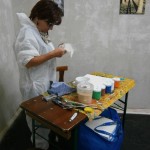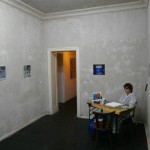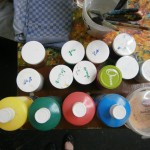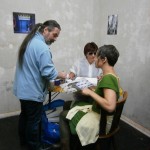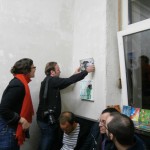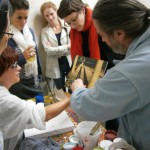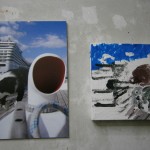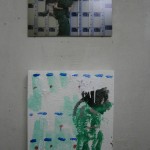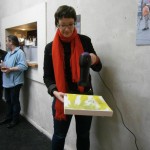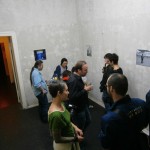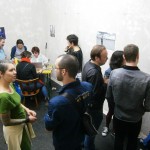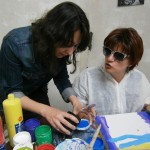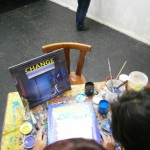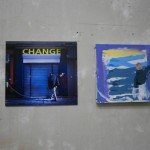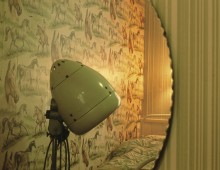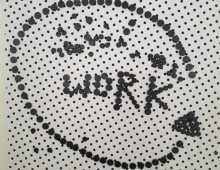Berlin | 2014
An exhibition and event by Silja Korn & Jan Bölsche,
curated by Kate Brehme
Opening night and event: 8pm, 15 August
Exhibition dates: 15-17 August
at Das Gift
Donaustrasse 119
12043 Berlin Neukölln
http://dasgift.tumblr.com/
Zusammenspiel explored the creative process of interpretation and description essential to the practices of two Berlin based artists with visual impairments, Jan Bölsche and Silja Korn. Below you will find a short video documenting the opening night performance, a text reflecting on the project written by myself, and images of the exhibition.
Reflecting on Zusammenspiel
Photography’s ability to present “truth” or “reality” has long been debated throughout history. While photography has become an accepted part of contemporary art practice worldwide, photography by artists with visual impairments has not. Is it because a photograph taken by someone with a visual impairment is considered less of a “real” representation due to the fact that the photographer is capturing something “unknown” to them? Can we not look at it from a different perspective: an indication that all visual images are only a matter of interpretation of different realities? Painting, on the other hand is regarded as a medium with a certain permission to distort what is seen through the artist’s interpretation of reality. But what happens when that artist’s reality of a visual world is reliant on the interpretations of others?
Zusamenspiel explored the role that interpretation plays within the creative process essential to the practices of two Berlin based artists with visual impairments, Jan Bölsche and Silja Korn. Both artists use various ways to “see” and capture the visual world around them – Jan through digital technology that allows him to capture and enlarge visual details he would otherwise not be able to see, and Silja, through hearing verbal descriptions that create images within her imagination that she translates onto a physical surface.
Zusammenspiel explored what – aside from an afterthought or an educational tool – the interpretation of visual imagery could be. We wanted to question: what happens to an image when it is interpreted not just in the instance that it is captured by the artist, but again when it is described by someone, interpreted by someone else into a different medium, and then interpreted yet again by its audience? Do multiple interpretations, reduce or add to its meaning or “truth”?
Zusammenspiel is from the German, meaning a “co-operation”, “interaction” or “teamwork”. Jan, Silja and I selected this title at the beginning of our collaboration, as a way of describing not only our way of working together on the project, but also what we hoped would describe the process of interpretation that our visitors would engage in.
As visitors entered the gallery on opening night, they encountered eight photographs by Jan hanging on the walls, and Silja sitting in the corner of the gallery at a table prepared with blank canvases and pots of paint. After a brief introduction to the artists and the exhibition, the audience was then encouraged to participate in the creation of the rest of the exhibition by describing Jan’s photographs to Silja so that she could interpret them live in painted form.
Many visitors were intrigued by the idea and jumped at the opportunity to take part. However, like many other performative art projects hoping to transform passive audience members into active participants, the interaction we desired from our audience presented many unexpected challenges.
Firstly, some visitors voiced concerns about the way in which Silja was “presented” as an artist with a disability. Some felt that the whole performance could be interpreted as yet another “freak show” featuring the disabled artist as exotic and different. While I profoundly disagree with this position as it was Silja’s choice to perform her live painting performance in the way that she did, as she had done for similar exhibition openings in the past, I agree that the distinction between the fact that it was her choice, and not my curatorial decision, was not made obvious enough. This criticism was perhaps reinforced by another which suggested the performance was “too staged” because it wasn’t an accurate depiction of how Silja works in her studio when she paints. As I explained to our concerned visitors, when Silja paints, it is often done independently through relying on her memory and senses alone, rather than using someone else’s interpretation. However, as a performance doesn’t have to replicate the private studio practice of an artist, and because our intent was to highlight the importance of interpretation, Silja selected the interpretation process that occurs when she employs other methods such as photography where she does rely on verbal descriptions from others, as a key part of the performance.
Secondly, other visitors expressed dismay at the ways in which some of the participants interacted with Silja during the performance. While most participants used language to describe Jan’s images to Silja and occasionally guided Silja’s hands to help her find the edges of the canvas or the colour paint she was looking for, others took her hand and guided her brush strokes quite deliberately. This was seen by some as a symbolic act of power being taken from the disabled person and I was asked to step in and prevent this from happening. However knowing that Silja was quite capable of stopping any undesirable outcomes herself, I did not.
I later questioned Silja about whether or not she felt powerless in these moments. While she could understand this argument, for Silja, the performance was never about power struggles between disabled and non-disabled or sighted and visually impaired people but rather was about exploring the different ways people interpreted an image. For some, descriptive words were easier, for others it was movement that allowed them to best communicate. Some were able to describe colours, textures and shapes in great detail, while others told a narrative or evoked mood.
The performance lasted the entire two hours we set aside for the opening and resulted in a total of four painted interpretations of Jan’s photographs. We displayed the works together with the artists offering their combined efforts as one collaborative work.
Artist Biographies
Jan Bölsche is a Berlin based photographer and author. His photos have been published in a variety of newspapers, magazines, travel guides, catalogues and on websites and CD covers. He specializes in capturing the “decisive moment”. Jan has provided professional photography services for recent events such as the Konferenz K2 in Berlin titled “Eine Dialogveranstaltung der Kulturverwaltung des Berliner Senat”. Jan has “Stargardt’s disease” or Juvenile Macula Degeneration (JMD) a visual impairment that affects his eye’s photoreceptors for. The sensation of color is quite different from what the rest of us see and due to the lack of high definition input, Jan’s visual cortex concentrates more on the ‘big picture’, the coarse composition rather than on fine detail.
Silja Korn is a Berlin based artist. She has been exhibiting throughout Germany since 2008 and works in a variety of media including painting and digital photography. Silja employs the use of her fingers, with brushes, spatulas, natural sponges, and wooden sticks and often incorporates paper, stones, sand, wood slats and pastes in her paintings. Recent exhibitions have been shown at Wassergalerie der Berliner Wasserbetriebe, Berolina Galerie, the 2013 Festival of Lights, Schillerpalais, and the Stadt- und Technikmuesum in Ludwigsfelde. Silja has been blind since childhood.



